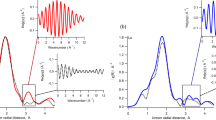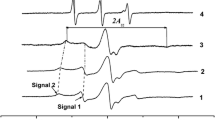Abstract
Acid-base equilibria and interfacial electrostatic properties of hydrated mesoporous and nanostructured alumina powders are determining factors for the use of these materials in heterogeneous catalysis and as a sorption media for filtration and chromatographic applications including life sciences. Here spin probe electron paramagnetic resonance spectroscopy of pH-sensitive nitroxides was employed to evaluate the surface charge and interfacial acid-base equilibria at the pore surface of mesoporous powders of α-Al2O3, γ-Al2O3, Al2O3 × nH2O, and basic γ-Al2O3 and nanostructured Al2O3 in the form of pristine materials and modified with aluminum-tri-sec-butoxide, hydroxyaluminum glycerate, and several phospholipids. A new pH-sensitive nitroxide probe, 4-dimethylamino-5,5-dimethyl-2-(4-(chloromethyl)phenyl)-2-ethyl-2,5-dihydro-1H-imidazol-1-oxyl hydrochloride semihydrate (nitroxide R1), has been synthesized and characterized. It was found that conditions of preparation of alumina powders exert strikingly large effects on the apparent pK a of nitroxides measured from electron paramagnetic resonance titration curves. Specifically, while the electron paramagnetic resonance titrations curves for the nitroxide R1 in mesoporous powders prepared from basic γ-Al2O3 and Al2O3 × nH2O were shifted by ΔpK a≈ +0.6 and up to ≈ +1.2 pH units respectively, the shift for γ-Al2O3 was found to be much higher: ΔpK a = +3.5. Assuming approximately the same ∆pH = 0.5–1.0 arising from a difference in the hydrogen ion activity between the bulk solution phase and that in a confined pore volume, the samples were ranked in the following order of descending magnitude of the effective surface electrostatic potential Ψ: mesoporous γ-Al2O3 > Al2O3 × nH2O > basic γ-Al2O3 > α-Al2O3. Conditions of the Al2O3 synthesis as well as the surface modification procedures were found to have profound effects on the interfacial electrostatic properties of hydrated samples that are likely related to the nature and concentration of the active sites on the alumina surfaces.








Similar content being viewed by others

References
Hudson, L. K., Misra, C., Perrotta, A. J., Wefers, K., Williams, F. S. (2000). Ullmann’s encyclopedia of industrial chemistry. Wiley-VCH Verlag GmbH & Co. Weinheim, Germany: KGaA.
Copeland, J. R., Santillan, I. A., Schimming, S. M., Ewbank, J. L., & Sievers, C. (2013). Surface interactions of glycerol with acidic and basic metal oxides. Journal of Physical Chemistry C, 117, 21413–21425.
Posner, G. H. (1978). Organic reactions at alumina surfaces. Angewandte Chemie International Edition in English, 17, 487–496.
Shinde, P. V., Shingate, B. B., & Shingare, M. S. (2011). Aqueous suspension of basic alumina: an efficient catalytic system for the synthesis of poly-functionalized pyridines. Bulletin of the Korean Chemical Society, 32, 459–462.
Yalamaç, E., Trapani, A., & Akkurt, S. (2014). Sintering and microstructural investigation of gamma–alpha alumina powders. Engineering Science and Technology, an International Journal, 17, 2–7.
Huang, C. P., & Stumm, W. (1973). Specific adsorption of cations on hydrous gamma-Al2O3. Journal of Colloid and Interface Science, 43, 409–420.
Akratopulu, K. C., Vordonis, L., & Lycourghiotis, A. (1986). Effect of temperature on the point of zero charge and surface dissociation-constants of aqueous suspensions of gamma-Al2O3. Journal of the Chemical Society-Faraday Transactions I, 82, 3697–3708.
Thomas, F., Bottero, J. Y., & Cases, J. M. (1989). An experimental-study of the adsorption mechanisms of aqueous organic-acids on porous aluminas .2. Electrochemical modeling of salicylate adsorption. Colloids and Surfaces, 37, 281–294.
Ntalikwa, J. W. (2007). Determination of surface charge density of alpha-alumina by acid-base titration. Bulletin of the Chemical Society of Ethiopia, 21, 117–128.
Wiese, G. R., & Healy, T. W. (1975). Coagulation and electrokinetic behavior of Tio2 and Al2O3 colloidal dispersions. Journal of Colloid and Interface Science, 51, 427–433.
Bowers, A. R., & Huang, C. P. (1985). Adsorption characteristics of polyacetic amino-acids onto hydrous gamma-Al2O3. Journal of Colloid and Interface Science, 105, 197–215.
Ruiz-Reina, E., Gomez-Merino, A. I., Rubio-Hernandez, F. J., & Garcia-Sanchez, P. (2003). Stern-layer parameters of alumina suspensions. Journal of Colloid and Interface Science, 268, 400–407.
Yelken, G. O., & Polat, M. (2014). Determination of electrostatic potential distribution by atomic force microscopy (AFM) on model silica and alumina surfaces in aqueous electrolyte solutions. Applied Surface Science, 301, 149–155.
Khlestkin, V. K., Polienko, J. F., Voinov, M. A., Smirnov, A. I., & Chechik, V. (2008). Interfacial surface properties of thiol-protected gold nanoparticles: A molecular probe EPR approach. Langmuir, 24, 609–612.
Tikhonov, A. N., Agafonov, R. V., Grigor’ev, I. A., Kirilyuk, I. A., Ptushenko, V. V., & Trubitsin, B. V. (2008). Spin-probes designed for measuring the intrathylakoid pH in chloroplasts. Biochimica et Biophysica Acta-Bioenergetics, 1777, 285–294.
Molochnikov, L. S., Kovaleva, E. G., Golovkina, E. L., Kirilyuk, I. A., & Grigor’ev, I. A. (2007). Spin probe study of acidity of inorganic materials. Colloid Journal, 69, 769–776.
Shishmakov, A. B., Kovaleva, E. G., Mikushina, Y. V., Parshina, E. V., Molochnikov, L. S., & Petrov, L. A. (2010). Epr study of copper(II) complexes in the matrix of titania gel modified with powder cellulose. Russian Journal of Inorganic Chemistry, 55, 937–941.
Mekhaev, A. V., Pestov, A. V., Molochnikov, L. S., Kovaleva, E. G., Pervova, M. G., Yaltuk, Y. G., Grigor’ev, I. A., & Kirilyuk, I. A. (2011). Structure and characteristics of chitosan cobalt-containing hybrid systems. The catalysts of olefine oxidation. Russian Journal of Physical Chemistry A, 85, 1155–1161.
Kovaleva, E. G., Molochnikov, L. S., Parshina, E. V., Shishmakov, A. B., Mikushina, Y. V., Kirilyuk, I. A., & Grigor’ev, I. A. (2014). Effect of the surface charge on the complexing and catalytic properties of Cu2+-containing composite materials based on zirconia and powdered cellulose. Russian Journal of Physical Chemistry B, 8, 317–325.
Parshina, E. V., Molochnikov, L. S., Kovaleva, E. G., Shishmakov, A. B., Mikushina, Y. V., Kirilyuk, I. A., & Grigor’ev, I. A. (2011). Medium acidity and catalytic properties of composite Materials based on silica and titania and powder cellulose in the presence of Cu2+ ions. Russian Journal of Physical Chemistry A, 85, 452–456.
Mekhaev, A. V., Pestov, A. V., Molochnikov, L. S., Kovaleva, E. G., Yatluk, Y. G., Grigor’ev, I. A., & Kirilyuk, I. A. (2011). Investigation of the structure of chitosan hybrid systems by pH-sensitive nitroxyl radical. Russian Journal of Physical Chemistry A, 85, 987–992.
Kovaleva, E., Molochnikov, L. (2012). Nitroxides—theory, experiment and applications. In A. I. Kokorin (Ed.), pH-sensitive nitroxide radicals for studying inorganic and organo-inorganic materials and systems, chapter 7 (pp. 211–246). Rijeka: InTech.
Voinov, M. A., Kirilyuk, I. A., & Smirnov, A. I. (2009). Spin-labeled pH-sensitive phospholipids for interfacial pK a determination: Synthesis and characterization in aqueous and micellar solutions. Journal of Physical Chemistry B, 113, 3453–3460.
Voinov, M. A., Rivera-Rivera, I., & Smirnov, A. I. (2013). Surface electrostatics of lipid bilayers by EPR of a pH-sensitive spin-labeled lipid. Biophysical Journal, 104, 106–116.
Kovaleva, E. G., Molochnikov, L. S., Golovkina, E. L., Hartmann, M., Kirilyuk, I. A., & Grigoriev, I. A. (2015). Electrical potential near hydrated surface of ordered mesoporous molecular sieves assessed by EPR of molecular pH-probes. Microporous and Mesoporous Materials, 203, 1–7.
Kovaleva, E., Molochnikov, L., Osipova, V., Stepanova, D. and Reznikov, V. (2015) Electrosurface properties of nanostructured silica assessed by molecular pH labels. Applied Magnetic Resonance, 46(12), 1367–1382.
Woldman, Y. Y., Semenov, S. V., Bobko, A. A., Kirilyuk, I. A., Polienko, J. F., Voinov, M. A., Bagryanskaya, E. G., & Khramtsov, V. V. (2009). Design of liposome-based pH sensitive nanospin probes: Nano-sized particles with incorporated nitroxides. Analyst, 134, 904–910.
Karasyuk, N. V., Ivanova, A. S., Korneeva, E. V. (2016). http://www.findpatent.ru/patent/248/2482061.html. Accessed 17 Mar.
Kirilyuk, I. A., Bobko, A. A., Khramtsov, V. V., & Grigor’ev, I. A. (2005). Nitroxides with two Pk values—useful spin probes for pH monitoring within a broad range. Organic & Biomolecular Chemistry, 3, 1269–1274.
Kovaleva, E. G., Molochnikov, L. S., Venkatesan, U., Marek, A., Stepanova, D. P., Kozhikhova, K. V., Mironov, M. A., & Smirnov, A. I. (2016). Acid-base properties of nanoconfined volumes of anodic aluminum oxide pores by EPR of pH-sensitive spin probes. Journal of Physical Chemistry C, 120, 2703–2711.
Kovaleva, E. G., Molochnikov, L. S., Golovkina, E. L., Hartmann, M., Kirilyuk, I. A., & Grigor’ev, I. A. (2013). Dynamics of pH-sensitive nitroxide radicals in water adsorbed in ordered mesoporous molecular sieves by EPR spectroscopy. Microporous and Mesoporous Materials, 179, 258–264.
Khramtsov, V. V., Volodarsky, L. B. (2002). Biological magnetic resonance, vol. 14: Biological magnetic resonance In L. Berliner (Ed.), Use of imidazoline nitroxides in studies of chemical reactions: ESR measurements of concentration and reactivity of protons, thiols and nitric oxide (pp. 109–180). New York: Plenum Press.
Gulla, A. F., & Budil, D. E. (2001). Orientation dependence of electric field effects on the g-factor of nitroxides measured by 220 GHz EPR. Journal of Physical Chemistry B, 105, 8056–8063.
Voinov, M. A., Smirnov, A. I. (2015). Methods in enzymology, vol. 564. In P. Z. Qin and K. Warncke (Eds.), Ionizable nitroxides for studying local electrostatic properties of lipid bilayers and protein systems by EPR, chapter 7 (pp. 191–217). New York: Academic Press.
Smirnova, T. I., Voinov, M. A., Smirnov, A. I. (2009). Encyclopedia of analytical chemistry. Chichester, United Kingdom: Wiley.
Budil, D. E., Lee, S., Saxena, S., & Freed, J. H. (1996). Nonlinear-least-squares analysis of slow-motion epr spectra in one and two dimensions using a modified Levenberg-Marquardt algorithm. Journal of Magnetic Resonance Series A, 120, 155–189.
Smirnov, A. I. (2008). Post-processing of EPR spectra by convolution filtering: calculation of a Harmonics’ series and automatic separation of fast-motion components from spin-label Epr spectra. Journal of Magnetic Resonance, 190, 154–159.
Goldberg, S., Davis, J. A., Hem, J. D. (1996). The environmental chemistry of aluminum. In G. Sposito (Ed.), The surface chemistry of aluminum oxides and hydroxides (pp. 272–331) Boca Raton, FL: CRC Press, Inc.
Smirnov, A. I., & Poluektov, O. G. (2003). Substrate-supported lipid nanotube arrays. Journal of the American Chemical Society, 125, 8434–8435.
Acknowledgments
This work was supported by the Russian Foundation for Basic Research (Grant 14-03-00898), the Program 211 of the Government of the Russian Federation No. 02.A03.21.0006 and the State Tasks of the Ministry of Education (Russian Federation) No. 4.1626.2014/K and No. 2014/239. Fabrication and SEM characterization of AAO, least-squares fitting of EPR spectra and the final preparation of the manuscript were supported by U.S. DOE Contract DE-FG02-02ER15354 to AIS. The authors are thankful to Mrs. Ksenia Kozhikhova (Department of Technology for Organic Synthesis, Ural Federal University, Yekaterinburg, Russia) for preparation of positively-and negatively-charged liposomes. The help and useful discussions with Prof. Maxim A. Voynov and Dr. Antonin Marek (both from NCSU) are gratefully acknowledged.
Author information
Authors and Affiliations
Corresponding authors
Ethics declarations
Conflict of Interest
The authors declare that they have no competing interests.
Rights and permissions
About this article
Cite this article
Kovaleva, E.G., Molochnikov, L.S., Stepanova, D.P. et al. Interfacial Electrostatic Properties of Hydrated Mesoporous and Nanostructured Alumina Powders by Spin Labeling EPR. Cell Biochem Biophys 75, 159–170 (2017). https://doi.org/10.1007/s12013-016-0767-0
Received:
Accepted:
Published:
Issue Date:
DOI: https://doi.org/10.1007/s12013-016-0767-0



